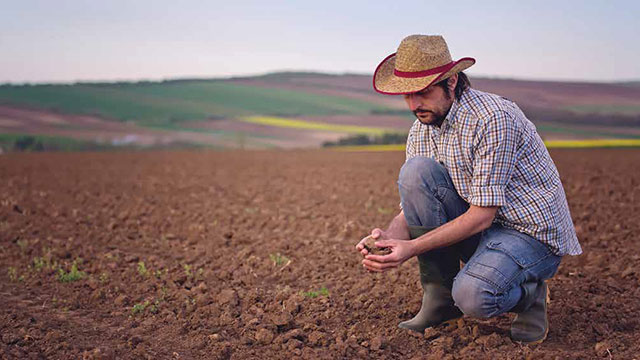The Growing Food Crisis
April 1, 2017

In the early 1900s, as the earth’s population began to multiply at an alarming rate, people began to realise that the population was beginning to outstrip the food supply. However, to put more land into the production of food required tilling and seeding more soil. Back then, humankind was limited to draft animals and ploughs to turn the soil. But the invention of the tractor arrived just in time, enabling farmers to plant as much acreage as they owned. In addition, the mining of phosphate and the production of petroleum by-products made fertiliser plentiful and cheap, and its increased use enabled farmers to grow bigger and better crops. As a result, by the 1940s, farming was being done on a large scale; food was plentiful—and the birth rate accelerated.
Then, beginning in 1973, genetic engineering enabled farmers to grow more fodder for cattle feed and larger, nicer ears of corn for the many foodstuffs and things that utilise corn in their production. This ability to grow larger and healthier plants using the science of genetics began what became known as the green revolution. For example, through the work of American biologist Dr Norman Borlaug, Mexico was able to develop a stronger wheat plant that produced twice as much grain. Prior to its development, hunger was a way of life for many in Mexico, because the country had to import half of its wheat and many people could not afford to purchase the grain. With the development of the new strain of wheat, Mexico has been able to supply its populace with affordable wheat and even export its excess.
Much of the earth’s populace lives on rice, including the people of India. In the early 1960s, India was on the brink of mass famine due to a rapidly growing population. Through the work of Dr Borlaug and the Ford Foundation, a new variety of rice, called IR8, was developed. It was engineered to produce more grains per plant when grown with irrigation and fertilisers. Today, thanks to the green revolution, India is one of the world’s leading producers of rice. Farmers in other parts of the world also began using IR8 and the development of hybrid plants went into full production. As a result, malnutrition in many countries was greatly reduced. The green revolution has alleviated food shortages in much of the world, except for parts of Africa, which have lagged behind largely due to internal problems.
In addition to deploying fertilisers and hybrids that resulted in faster and better yields, farmers also learned that they could now grow two crops per year on the same piece of land. This advance didn’t come without a price, however, since fertilising without allowing the land to rest results in each new crop being slightly less productive than the one before it. Monoculture farming, in which hundreds of hectares of land are repeatedly planted with the same crop, also began to exhaust the soil.
China provides an example of what can happen from this kind of farming. Since large portions of China’s land have become unproductive, it is now transplanting entire communities to more unproductive land so the area the village once occupied can be cultivated as farmland. Also, salt from fertilisers has started accumulating in the soil, making it unproductive. In fact, over fertilisation, soil depletion, desertification and deforestation of the world’s soil has contributed to making some four billion hectares of land unproductive, which represents 45 per cent of the earth’s vegetated surface!
One of the main ingredients in fertiliser is phosphate, and the African nations of Morocco and Western Sahara contain 80 per cent of the world’s supply. It is estimated that by 2030, the global demand for phosphate will exceed the supply. Global food production at that point will almost certainly plummet, meaning that ever-larger segments of the earth’s population could suffer hunger. Burgeoning populations also require ever more land for housing; and as the earth’s cities expand, a land area equivalent to the country of Portugal is covered with concrete each year.
The demand for land and lumber is playing havoc with the world’s rainforests. At one time, these forests covered 12 per cent of the earth’s surface; today, it’s a mere 2 per cent. Half a hectare of rainforest disappears every second, which equates to an area of land the size of Belize each year. The rainforests supply 20 per cent of the earth’s oxygen and they recycle the carbon dioxide we produce. Yet, it’s predicted that in 20 years the rainforests will be gone, along with the plants and species that inhabit them. In the interim, if immediate steps aren’t taken to stop the harvesting of lumber in the rainforests, the supply of the world’s oxygen will decrease even more.
To summarise, we know that the earth’s population will continue to grow, resulting in corresponding increases in the demands for food and fertile land. We’ve reached our limit regarding land that’s available for food and lumber production; in fact, each year we have less of it, not more. Making the fertile land we do have more productive will require more fertiliser, but as was previously mentioned, it’s predicted that the supply of phosphate, a primary ingredient in the production of fertiliser, will be severely reduced by 2030. These aren’t issues that can be postponed and addressed 10 years down the road. They must be acted upon now. In fact, decades ago they were very serious issues that demanded humankind’s immediate attention then!
But there’s hope
Earth’s natural resources are disappearing. With each passing year, the problems grow larger and more perplexing. How can our divided world possibly unite to solve these crises?
Fortunately, in spite of appearances, there’s really no cause for fear. Rather, we can look forward in hope, because Jesus’ soon return is a light at the end of earth’s dark tunnel. Jesus Himself said, “Now when these things begin to happen, look up and lift up your heads, because your redemption draws near” (Luke 21:28).* While we have a clear biblical mandate to take good care of our earth between now and Christ’s second coming, His return will mean the arrival of a new and perfect earth where we won’t need to worry about the finiteness of earth’s natural resources, because there’ll be “no more death, nor sorrow, nor crying. There shall be no more pain, for the former things have passed away” (Revelation 21:4).
It’s great to anticipate the end of the world and Jesus’ second coming, but He also offered us these words of caution: “Take heed that no one deceives you” (Matthew 24:4). The only way to keep from being deceived is to know what the Bible says about the second coming.
The first thing to notice is that Jesus’ coming won’t be secret or hidden. “Behold, He is coming with clouds, and every eye will see Him, even they who pierced Him. And all the tribes of the earth will mourn because of Him. Even so, Amen” (Revelation 1:7). Jesus’ own words are the clearest instruction we can receive. In describing His return, Jesus used the phrase “So also will the coming of the Son of Man be” at least four times. This is what it will be like: “For as the lightning comes from the east and flashes to the west, so also will the coming of the Son of Man be” (Matthew 24:27).
But will we be ready?
Jesus also compared His second coming to the days of Noah: “As the days of Noah were, so also will the coming of the Son of Man be. For as in the days before the flood, they were eating and drinking, marrying and giving in marriage, until the day that Noah entered the ark, and did not know until the flood came and took them all away, so also will the coming of the Son of Man be” (Matthew 24:37–39). What an accurate picture of our day! “Eating and drinking” consumes much of people’s leisure time, with no thought of eternity or the consequences of sin. People are busy satisfying their lustful desires and even the act of “marrying and giving in marriage” is no longer regarded as sacred as it used to be. Some of the saddest words spoken in the Bible are found in these verses: “And [they] did not know.” Multitudes, blinded by the cares of this life, don’t know that Jesus’ return is near, “even at the doors” (verse 33, KJV).
Christ also told us that just before His return, men and women would be too preoccupied with the things of this life to be concerned with what’s coming. “Likewise as it was also in the days of Lot: They ate, they drank, they bought, they sold, they planted, they built; but on the day that Lot went out of Sodom it rained fire and brimstone from heaven and destroyed them all. Even so will it be in the day when the Son of Man is revealed” (Luke 17:28–30). The comparisons are too obvious for us to ignore. The hour is late. Now is the time for each one of us to prepare for the coming of the Lord.
Considering the signs of His return that are occurring today, we can be confident in knowing that Jesus will keep His word. “Let not your heart be troubled; you believe in God, believe also in Me. In My Father’s house are many mansions; if it were not so, I would have told you. I go to prepare a place for you. And if I go and prepare a place for you, I will come again and receive you to Myself; that where I am, there you may be also” (John 14:1–3).







